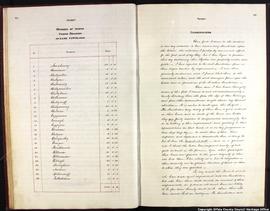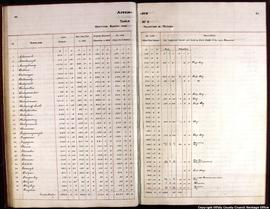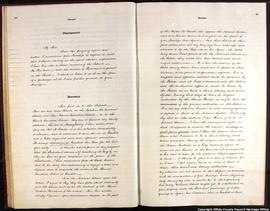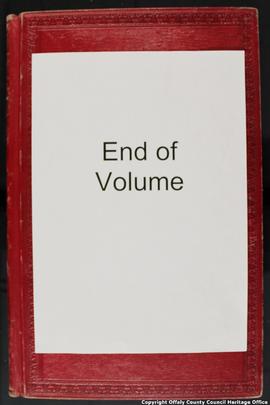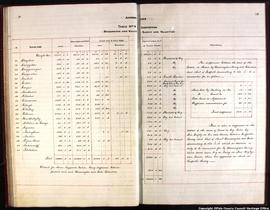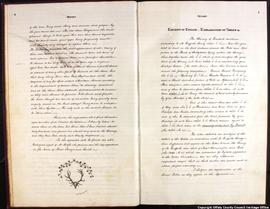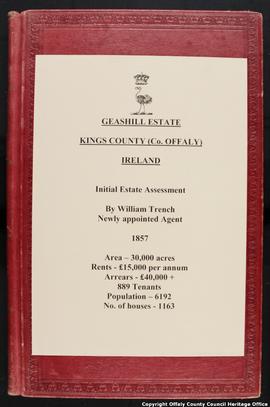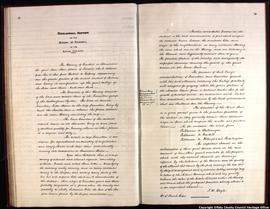Zona de identificação
Código de referência
Título
Data(s)
- 1857-1963 (Produção)
Nível de descrição
Arquivo
Dimensão e suporte
Zona do contexto
Nome do produtor
História biográfica
The Barons Digby of Geashill in the King's County derive their title from Lettice, the only daughter of Gerald, Lord Offaly, eldest son of the Earl of Kildare (1559-1580). Lettice married Sir Robert Digby of Coleshill, Warwickshire. He died in 1618 but Lettice, Lady Digby, then laid claim to the barony of Geashill and the estates of her grandfather, the Earl of Kildare, as heir general. The case was decided against her and in appeasement, James I created her Baroness of Offaly for life and awarded her the barony of Geashill. Her eldest son, Robert, was created Lord Digby of Geashill in the Peerage of Ireland in 1620. The title passed in direct descent until the death of Edward, 8th Baron Digby who died without issue in 1856. It was then passed to his cousin Edward St Vincent, 9th Baron Digby, from whom the present Lord Digby derives his title. In 1765, the 7th Baron Digby was also created 1st Baron Digby in the Peerage of Great Britain. In 1790, he was also created Viscount Coleshill and Earl Digby. The viscountcy and the earldom became extinct on the death of the 8th Baron in 1856, but both baronetcies (Baron Digby of Geashill in the King's County and Baron Digby of Sherbourne in the County of Dorset) continue to the present day.
Nome do produtor
História biográfica
Trench, the youngest of fifteen children was born near Ballybrittas, Queen’s County in 1808, he was named Richard. His younger brother who died in infancy was christened William. However, from a young age his name was changed to William Steuart. His father, Thomas, was the Church of Ireland Dean of Kildare, his mother was the daughter of Walter Weldon of Rahinderry, Co.Laois, who was MP for Athy. He grew up in the family home Glemalyre (Glenamalire) in Bellegrove, 3kms from Portarlington. At the age of 13 he was sent to be educated at the Royal School, Armagh, where he spent six years. He later studied Classics and Science in Trinity College Dublin. On leaving Trinity he began to study agriculture and land management, carrying out improvements on his brother’s estate in Kilmorony in Co. Laois, once home of the Weldon family. He then acquired land in Cardtown in the Slieve Bloom Mountains, where he was involved in carrying out reclamation, and began extensive potato cultivation.
In 1832 he married Elizabeth Sealy Townsend, whose father was the Master of Chancery in Ireland at the time. They had one daughter, Anna Maria, born 30 January 1836. Thomas Weldon Trench was born on 11 February 1833 and John Townsend Trench was born on 17 February 1834.(Elizabeth's brother, Richard Townsend , later married William Steuart’s sister Helena.)
Trench was an author. His most famous piece of work was 'Realities of Irish Life' which was published in London in 1868. He also wrote 'Ierne' (London, 1871), and produced many short articles including sketches published in the 'Evening Hours' (London, 1871-72). However, for most of his life he was employed as a professional land agent, a position he considered himself well qualified for. He claims in 'Realities' “to have lost no opportunity of acquiring information which might qualify me to become a land agent as being the most suitable, in its higher branches to my capacity.” He was appointed agent to the Shirley estate in Co Monaghan in April 1843 but resigned in April 1845. In December 1849 he was appointed agent to the estates of the Marquess of Lansdowne in Co Kerry. Two years later he took charge of the property of the Marquess of Bath in Co. Monaghan and that of Lord Digby in King's County in 1857 and held these appointments close to his death in 1872.
Trench was noted for the improvements carried out on the estates he managed. Under his agency the Barony of Geashill experienced a golden age of prosperity. There were vast improvements in both the architecture of the village and the topography of the landscape. Such improvements gained both national and indeed international recognition for Lord Digby and earned Trench the legacy of an improver who was well ahead of his time. Similar improvements in the layout and quality of the land as well as the construction of dwellings for example a terrace of cottages in Carrickmacross were built by Trench for the key workers on the Bath estate in Co. Monaghan. With the help of his son John Townsend Trench he transformed the Lansdowne estate by improving the dwelling houses of the tenantry, raising the standard of farming, improving local services and developing local industries and fishing. He had similar plans for the Shirley Estate, which he was not allowed to pursue, leading him to resign his agency.
To facilitate such improvements Trench embarked upon the implementation of assisted emigration schemes or what he referred to as ‘voluntary’ emigration. For example in assisted emigration from the Shirley estate 1843-54, it is noted that by 1851 the flow of assisted emigrants was reduced to a trickle. However, that year marked the beginning of a significant outflow of assisted emigrants from the neighbouring Bath estate, under the agency of William Steuart Trench. Similar schemes were carried out while he worked in Kenmare in Co Kerry, where he helped to ship over 4000 destitute people to the United States and Canada. Trench looked upon such schemes as a cheap and efficient way to improve the estate. While Trench was noted for his assisted emigration schemes in Counties Kerry and Monaghan, records show that the amount of money spent on emigration in Geashill was mimimal. Nonetheless the population decreased by 40.3%. during the Trench years suggesting that in an attempt to clear the estate to make way for improvements, many people were forced to leave, receiving little or no money from him.
While Trench’s physical legacy is a positive one, there is much evidence of discontent among the tenantry especially in counties Offaly and Monaghan, which led to a flame of agitation and the rise of Ribbonism. His physical legacy was greatly overshadowed by the realities of an agent who broke leases, levelled people’s homes and banished the poor and in so doing was often ruthless in his management of the estates in his charge. In a gradual process between, December 1871 and January 1872, Reginald Digby, Lord Digby’s nephew, replaced the Trenches as land agent in Geashill. Both Trench and his son Thomas Weldon died within a few days of each other in 1872 and were buried in Co. Monaghan in Donaghmoyne cemetery.
Many of Trench’s relatives were also employed as agents throughout the country: his cousin, Benjamin Bloomfield Trench worked as agent to Charles Verner (1854) and was also agent on the Bath estate 1868-1875. George Trench was employed on the Talbot-Crosbie estate in Co. Kerry while his cousin, William Trench acted as agent on the Heywood estate in Queen’s County. Other members of the Trench family held important positions in the church, for example: Richard Chenevix Trench was archbishop of Dublin from 1864 to 1884.
Nome do produtor
História biográfica
Thomas Weldon Trench was born on 11 Feb 1833. He was the eldest son of William Steuart Trench and Elizabeth Susanna Townsend. Thomas Weldon was installed by his father William Steuart Trench as co–agent and local magistrate on the Digby estate in Geashill in 1857. He also acted as assistant agent on the Bath estate in Co. Monaghan. During his agency in King's County, the Barony of Geashill experienced vast improvements in both the architecture of Geashill village and the topography of the landscape. While Thomas Weldon played an instrumental role in such a transformation, he adopted a hard line authoritarian style of estate management. This is reflected in his ruthless tactics to clear the estate of small tenants and beggars, in order to create larger holdings with better drainage and more advanced farming methods. The case of Alice Dillon illustrates how the actions of Thomas Weldon Trench were ruthless and hasty in dealing with the removal of a beggar woman from the estate on Christmas Eve in 1861. His actions were questioned by the Lord Chancellor, from whom he received a strong reprimand and warning, an episode he omitted in the annual reports to Lord Digby.
Hi agency was also marked by the rise of Ribbonmen and a flame of agitation likely to be the response of aggrieved tenants towards his style of management. Similar hostilities to him existed in Co. Monaghan. By 1870, Thomas Weldon Trench resigned his post as resident agent in Geashill
and subsequently became a medical volunteer in the Franco-Prussian War. This was short-lived due to illness and he returned to Ireland later that year. He died at the relatively young age of 39 in Carrickmacross, Co. Monaghan on 15 August 1872, which was just shortly after the death of his father, W. S., on the 4 August 1872. They are both buried in Donaghmoyne churchyard, Carrickmacross.He remained unmarried and died on the 15th of August 1872.
Nome do produtor
História biográfica
Reginald Digby was the fifth son of Rev Kenelm Henry Digby, rector of Tittleshall in Norfolk, younger brother of Edward, 9th Lord Digby. Reginald was born in 1847 and married Caroline Grace, daughter of Rev Thomas Fremeaux Boddington in 1872. They had three daughters and one son, Lionel Kenelm Digby, rector of Tittleshall, who was killed in action in 1918. He became resident agent on the Geashill Estate in 1871 following the resignation of Thomas Weldon Trench and sole agent in 1872 on the death of William Steuart Trench. He retired in 1923, having served as agent for nearly fifty years, although by this time he had more or less transferred the agency to Lewis Goodbody of A & L Goodbody, solicitors, Tullamore, who continued as agents for the Digby family. Like the previous resident agents before him, he lived at Geashill Castle. In 1922, he needed to go to London for an operation, but was unwilling to leave the house unattended, knowing that an empty house would be a target for burning. Eventually, he could wait no longer, and the house was burned down in his absence. He died in 1927.
Nome do produtor
História administrativa
A. E. or Alfred Edwin Goodbody was admitted a solicitor in 1881, having secured a silver medal at the final examinations of June 1880. He soon after set up on his own account at 15 Dame Street and later, probably in 1888 or in 1889, went into partnership with Archibald Tisdall who was based in Tullamore. He was joined in the partnership by his brother Lewis in 1891 and after this, Tisdall appears to have worked in Birr and later, after 1900, at the Dublin office. He left the partnership in 1901 and the new firm of A & L Goodbody commenced in 1902.
In 1903, the Wyndham Land Act was passed which allowed a 12 % bonus to landlords who sold entire estates to the Estates Commissioners to administer the sales under the Act. Lewis Goodbody was well placed to secure the business. He was of a Quaker family and all the other solicitors practising in Tullamore were Catholics. In 1905 Alfred sent Lewis a sum of £150, being his share of £500 secured for the sale of the Longworth-Dames estate to the Congested Districts Board. The other £200 he was holding to advance on mortgage to a client whom he was mindful of retaining. He seems to have been getting 1% on such sales but was able to quote to landlords the then Law Society scale of 2.5% and bargain thereafter. In the case of Lord Digby’s 30,000 acre estate in King’s County the firm was probably in for £3,000 fees if the matter proceeded on a total sale value of £300,000. Digby was looking for 0.75% and Lewis 1.25%. Digby had made enquiries from other landlords but so had Alfred suggesting that he would have remained firm on the 1% as is clear from a letter Alfred wrote to his brother in February 1908. With the end of the ‘big money’ estate sales, the war and the downturn thereafter inevitably the Tullamore office would have been less profitable. By this time the Dublin office was expanding and had taken in new solicitors such as G. A. Overend who was a partner in the firm by 1913 and probably commenced practice there on qualifying in 1907.
Kenneth A. Kennedy joined the firm after the death of Alfred in 1924 and was probably a partner in the Tullamore office by 1930. Kennedy was called to the bar in 1917 and qualified as a solicitor in 1924. In 1930 Kenneth Kennedy, Lewis Goodbody and G. A. Overend acquired the fee simple as joint tenants of the office premises at High Street, Tullamore held on lease since 1913. Lewis Goodbody died in 1933 and the ownership of the firm (at least as far as Tullamore was concerned) was shared between G. O. Overend and Kenneth A. Kennedy, but not necessarily in equal shares. In 1947 a new partnership arrangement was entered into between Overend and Kennedy and the following year Kenneth A. Kennedy acquired the entire interest in the building at High Street for £800. The A & L Goodbody partnership in the Tullamore office appears at this time to have comprised of G. A. Overend, Kenneth A. Kennedy and G. G. Overend. The Tullamore building was to serve the Tullamore firm, known since the late 1940s as Goodbody & Kennedy, until 1989 when the business was sold to Dermot Scanlon by Kenneth C. P. Kennedy. Kenneth A. Kennedy had remained a partner in A & L Goodbody, Dublin until his death in December 1974 at the age of 80 but the Dublin office had no involvement in the Tullamore firm probably from the late 1940s.
Nome do produtor
História administrativa
Kenneth A. Kennedy joined the firm of A. & L. Goodbody after the death of Alfred Goodbody in 1924 and was probably a partner in the Tullamore office by 1930. Kennedy was called to the bar in 1917 and qualified as a solicitor in 1924. In 1930 Kenneth Kennedy, Lewis Goodbody and George Acheson Overend acquired the fee simple as joint tenants of the office premises at High Street, Tullamore held on lease since 1913. Lewis Goodbody died in 1933 and the ownership of the firm (at least as far as Tullamore was concerned) was shared between G. O. Overend and Kenneth Arthur Kennedy, but not necessarily in equal shares. In 1947 a new partnership arrangement was entered into between Overend and Kennedy and the following year Kenneth Arthur Kennedy acquired the entire interest in the building at High Street for £800.13. The A. & L. Goodbody partnership in the Tullamore office appears at this time to have comprised of G. A. Overend, Kenneth A. Kennedy and G. G. Overend. The Tullamore building was to serve the Tullamore firm, known since the late 1940s as Goodbody & Kennedy, until 1989 when the business was sold to Dermot Scanlon by Kenneth C. P. Kennedy. Kenneth A. Kennedy had remained a partner in A & L Goodbody, Dublin until his death in December 1974 at the age of 80 but the Dublin office had no involvement in the Tullamore firm probably from the late 1940s.
Kenneth C. P. Kennedy (M 1949) was welcomed to the district court as a new solicitor in March 1950. Kenneth Kennedy practised with his father, K. A. Kennedy in the firm of Goodbody & Kennedy until the latter’s death and continued on his own account up to his retirement from full time practice in 1989. At that point the firm was incorporated into the firm of J D Scanlon, Tullamore where Mr Kennedy carried on as a consultant for several years.
Entidade detentora
História do arquivo
Zona do conteúdo e estrutura
Âmbito e conteúdo
Digitised collection of annual reports and rentals of the Geashill Estate, King's County sent by successive land agents to Lord Digby at his permanent residence in Dorset. Also includes two volumes of drawings depicting improvements made to labourers' cottages on the estate.
Avaliação, selecção e eliminação
Ingressos adicionais
Sistema de arranjo
Zona de condições de acesso e utilização
Condições de acesso
Condiçoes de reprodução
Copyright of digital images administered by Offaly County Council Heritage Office. No reproduction online, in print or broadcast without express permission of copyright holder. Original volumes in ownership of Lord Henry Noel Kenelm Digby, 13th Baron Digby.
Idioma do material
Script do material
Notas ao idioma e script
Características físicas e requisitos técnicos
Instrumentos de descrição
Zona de documentação associada
Existência e localização de originais
Annual reports and rentals Digby Irish Estates, Minterne House, Dorset.
Offaly County Library, P74 Digby Estate Valuation and Survey 1790-1799
Offaly County Library, P94, Geashill Estate rental receipt Bawnmore 1900
Offaly County Library, P95 Reginald Digby's Letterbook 1906-1914
Existência e localização de cópias
Unidades de descrição relacionadas
Zona das notas
Identificador(es) alternativo(s)
Pontos de acesso
Pontos de acesso - Assuntos
Pontos de acesso - Locais
Pontos de acesso - Nomes
Pontos de acesso de género
Zona do controlo da descrição
Identificador da descrição
Identificador da instituição
Regras ou convenções utilizadas
Datas de criação, revisão, eliminação
August 2016


